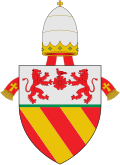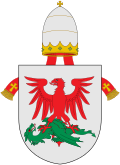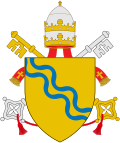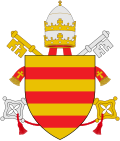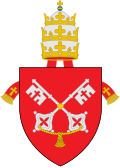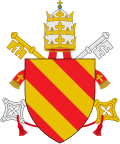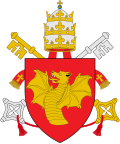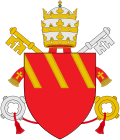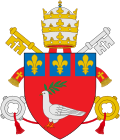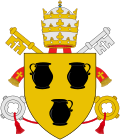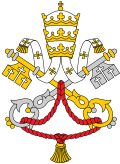| Arms | Description | Pope | Notes |
|---|
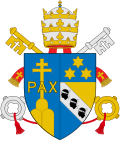 | Per pale, two coats: 1. Azure, a mountain of three coupeaux in base, thereon a patriarchal cross, its arms patées or; over all the word PAX in fess fimbriated sable; 2. Per bend or and azure, on a bend argent three Moor's heads couped sable wreathed of the third; on a chief of the second three estoiles argent, 1 and 2. | Pius VII (Barnaba Chiaramonti, 1800–1823) | It combines the coat of arms of the Benedictine order (at dexter) with that of the Chiaramonti family (at sinister). |
 | Azure, an eagle displayed argent (Azure, an eagle displayed or crowned of the same). | Leo XII (Annibale della Genga, 1823–1829) | |
 | Gules, a lion rampant argent holding a castle triple-towered or. | Pius VIII (Francesco Castiglioni, 1829–1830) | The attributed (traditional) arms of Celestine IV, canting arms for the name "Castiglioni". |
 | Per pale two coats; 1. Azure, two doves argent drinking out of a chalice or, in chief an estoile of the second. 2. Per fess azure and argent over all on a fess gules three mullets or, in chief a hat sable. | Gregory XVI (Bartolomeo Capellari, 1831–1846) | Combines the arms of the Camaldoli order (at dexter) with those of the Capellari family (at sinister). |
 | Quarterly, 1 and 4 azure a lion rampant crowned or, its hind foot resting on a globe of the last; 2 and 3 argent two bends gules. [26] | Pius IX (Giovanni Mastai-Ferretti, 1846–1878) | The first and fourth quarters are the arms of the Mastai family, and the second and third quarters those of the Ferretti family. |
 | Azure, on a mount in base a pine tree proper; between in dexter chief a comet, or radiant star, argent, and in base two fleurs-de-lis or. Over all a fess of the third. | Leo XIII (Gioacchino Pecci, 1878–1903) | The rays of the comet are usually drawn in bend-sinister, the pine tree is usually drawn like a cypress. [26] |
 | Azure, a three tined anchor in pale above waves of the sea proper, a six pointed star or in chief, on a chief argent a lion guardant winged and with nimbus or fimbriated sable displaying an open book inscribed PAX TIBI MARCE EVANGELISTA MEUS. | Pius X (Giuseppe Sarto, 1903–1914) | Sarto was of humble origin, and he adopted a coat of arms when he became Bishop of Mantua, in 1884, consisting of the main field and charges. When he became Patriarch of Venice in 1893, he added the chief of Venice (the Lion of St. Mark), changing the field from gules (red) to argent (white) to make the heraldic point that this was the "religious emblem of St. Mark's Lion and not the insignia [of the former Republic of Venice]". When he was elected pope in 1903, heraldists expected him to again drop the chief of Venice, but Sarto did not change his coat of arms. [27] |
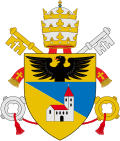 | Party per bend azure and or, a church, the tower at sinister, argent, essorée gules, the tower-cross of the second, in chief or, a demi-eagle displayed issuant sable, langued gules. | Benedict XV (Giacomo della Chiesa, 1914–1922) | The arms of the della Chiesa family with the imperial eagle added in chief. [28] |
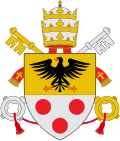 | Party per fess, in base Argent three torteaux Gules and on a chief Or an eagle displayed Sable armed Gules. | Pius XI (Achille Ratti, 1922–1939) | |
 | Azure a dove overt argent armed gules bearing an olive branch proper perched atop a trimount argent, a base wavy argent and azure soutenu by a divise vert. | Pius XII (Eugenio Pacelli, 1939–1958) | When a bishop and cardinal Pacelli's arms depicted a dove displayed (i.e., with its wings spread) holding an olive branch in its beak, a reference to his surname, which means "peace". The dove was perched on a trimount and sitting below the arc of a rainbow, an allusion to the story of Noah. After his election to the papacy, the dove was changed to be depicted with folded wings, the rainbow was removed, and the trimount placed atop a green field above waves of water. |
 | Gules a fess argent, over all a tower between two fleurs-de-lis in chief of the same, on a chief argent a lion guardant, winged, and with nimbus or fimbriated sable displaying an open book inscribed PAX TIBI MARCE EVANGELISTA MEUS. | John XXIII (Angelo Roncalli, 1958–1963) | John XXIII used the Roncalli family's coat of arms with the addition of the chief of Venice for the Patriarch of Venice (1953), following Pius X. |
 | Gules a collee argent issuant from base beneath three fleurs-de-lis in chevron of the same. | Paul VI (Giovanni Montini, 1963–1978) | The collee, or stylized mountains or hillocks are a cant of Paul VI's family name, Montini, which means "little mountains". |
 | Azure a collee argent issuant from base beneath three mullets of five points or in chevron, points to chief, on a chief argent a lion guardant, winged, and with nimbus or fimbriated sable displaying an open book inscribed PAX TIBI MARCE EVANGELISTA MEUS. | John Paul I (Albino Luciani, 1978) | John Paul I's coat of arms was put together to reflect both of the names he chose to take. The chief containing St. Mark's lion reflects not only his own service as Patriarch of Venice (1969), but also that of John XXIII (and Pius X, who also used this chief in his own arms). Cardinal Luciani's original arms replaced the fleurs-de-lis above the collee in his immediate predecessor's arms with four-pointed stars; when Luciani was elevated to Pope they were modified to become five-pointed stars which are a heraldic symbol of Our Lady, specifically of the Assumption. |
 | Azure a cross or, the upright placed to dexter and the crossbar enhanced, in sinister base an M of the same. | John Paul II (Karol Wojtyła, 1978–2005) | Wojtyła adopted his coat of arms in 1958, when he was created bishop, but with the charges in black instead of gold. As this violated the heraldic "tincture's canon" (black on blue, color on color) upon Wojtyła's election as pope, Vatican heraldist Monsignor Bruno Bernard Heim suggested he replace black by gold. [29] The design shows the "Marian Cross", a cross with a capital M for Mary inscribed in one quarter, recalling "the presence of Mary beneath the cross". [30] |
 | Gules, chape ployé or, with the scallop shell or; the dexter chape with a Moor's head proper, crowned and collared gules, the sinister chape a bear trippant (*passant) proper, carrying a pack gules belted sable. | Benedict XVI (Joseph Ratzinger, 2005–2013) | Designed by Andrea Cordero Lanza di Montezemolo in 2005. The charges, a scallop shell, Moor's head, Corbinian's bear, are taken from his previous coat of arms, used when he was Archbishop of Munich and Freising. Both the Moor's head and Corbinian's bear are charges associated with Freising in Bavaria, Germany. |
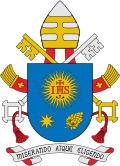 | Azure on a sun in splendour or the IHS Christogram ensigned with a cross pattée fiché piercing the H gules all above three nails fanwise points to centre sable, and in dexter base a mullet of eight points and in sinister base a spikenard flower or. [31] | Francis (Jorge Bergoglio, 2013–2025) | The gold star represents the Virgin Mary, the grape-like plant (spikenard) is associated with Saint Joseph, and the IHS emblem is the symbol of the Jesuits. [32] [33] [34] |
 | Per bend sinister azure and argent, in the first, a fleur-de-lis argent, in the second, a heart enflamed pierced by an arrow bendwise sinister, all gules, upon a book proper. [35] | Leo XIV (Robert Francis Prevost, 2025–present) | The white lily in a blue field indicating purity and innocence is associated with the Virgin Mary. In the white field (an ivory shade in the papal coat of arms) the book with the pierced heart represents the Order of Saint Augustine. The motto, In illo Uno unum ("In the One, [we are] one"), is from Saint Augustine's commentary on Psalm 127. [36] |







